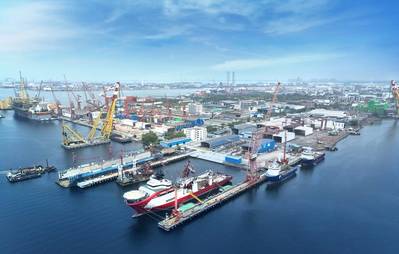AI, 5G, Digital Twins Deployed at Smart Shipyard
ST Engineering has officially opened its new shipyard located at 55 Gul Road in Singapore.
The Gul Yard was acquired in February 2023 for S$95 million ($74 million) and will replace ST Engineering’s Tuas Yard, whose lease expires at the end of 2024.
Twice the size of its existing Tuas Yard, the Gul Yard is designed to handle larger, more complex projects and will enable ST Engineering to explore new market segments, including offshore renewables projects, offshore support vessels for the oil and gas industry, as well as refits and upgrades.
The yard features:
AI-Driven Automation: ST Engineering’s AI-powered proprietary integrated yard management system oversees the entire ship repair process. It offers real-time insights for planning, tracking project status, predicting potential delays, and forecasting future capacity needs.
Predictive Maintenance & Condition-Based Monitoring: Predictive maintenance algorithms to prevent unplanned downtime by detecting early signs of equipment failure. Condition-based monitoring is also installed throughout the shipyard to monitor equipment and ships in real-time.
Digital Twin, Data Analytics and Sensemaking Technologies: Virtual replicas of ships for simulation, testing, and monitoring during the design and operational phases. Real-time performance tracking and diagnostics through digital twin integration. Real-time data analytics to enhance decision-making across production, maintenance, and operations. Process visibility across the yard, on board the ship, and within process plants.
5G Infrastructure: Pervasive wired and wireless connectivity delivers fast, reliable, and low-latency connections that support advanced automation, real-time data analytics, and enhanced operational efficiency.
Enhanced Worker Safety and Workload: ST Engineering’s AGIL Vision and security robot detects potential hazards and implement automated risk mitigation. Drones will be used to monitor hazardous and hard-to-reach areas to ensure worker safety. Automated guided vehicles (AGV) will also be used to transport materials, reducing worker workload and increasing efficiency. Smart track and trace devices, including smart watches and smart helmets (with live-streaming cameras), will track personnel while monitoring progress and track materials, assets, further optimising workflows and operational oversight.
Sustainability Initiatives: Electric vehicles such as AGVs and buggies will reduce emissions. The clean energy transition will involve implementing clean energy source such as ammonia, hydrogen, and biofuels by 2034 while expanding solar energy use. Optimised resources will involve efficiently sorting and recycling scrap to minimise waste.












